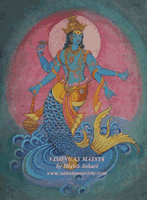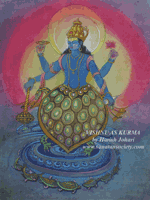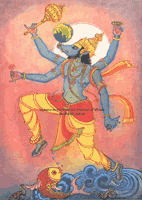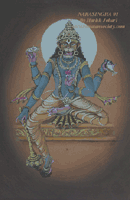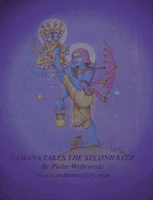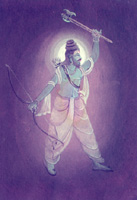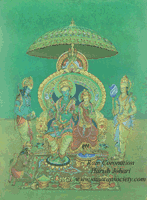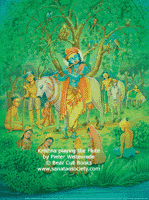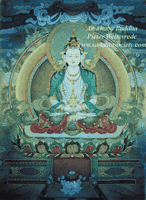Tulsi
is a sacred plant which can be found in almost every Hindu's home.
Tulsi Pooja (Worship of Tulsi) is observed almost every day. The sacred plant, Tulsi is
regarded as the incarnation of the goddess Mahalakshmi. Tulsi represents
duty, dedication, love, virtue and sorrow of all women. That is why
this herb is usually worshipped by women of all age groups.
"Every
home with a Tulasi plant is a place of pilgrimage, and no diseases, messengers
of Yama, the God of Death, can enter it."
Wherever the aroma of Tulasi is carried by the wind, it purifies the atmosphere
and frees all animals from all baser tendencies." Benefits of Worshiping Tulasi-devi
Although we can never fully describe the glories of Tulasi-devi, an eternal associate of Lord Krsna. The scriptures give us a hint of the value of worshiping her. The following list comes from the Padma Purana.
Tulasi is the essence of all devotional activities.
The leaves, flowers, roots, bark, branches, trunk, and shade of Tulasi-devi are all spiritual.
One who with devotion applies the paste of Tulasi wood to the Deity of Krsna will always live close to Krsna.
One who puts mud from the base of the Tulasi tree on his body and worships the Deity of Lord Krishna gets the results of one hundred days worship each day.
One who offers a Tulasi manjari to Lord Krishna gets the benefit of offering all other varieties of flowers, and he goes to the abode of Krishna.
One who sees or comes near a house or garden where the Tulasi plant is present gets rid of all his sinful reactions, including that of killing a brahmana.
Lord Krishna happily lives in the house, town, or forest where Tulasi-devi is present.
A house where Tulasi-devi is present never falls on bad times, and it becomes purer than all holy places.
The fragrance of Tulasi-devi purifies all who smell it.
Lord Krishna and all the demigods live in a house where mud from the base of the Tulasi tree is found.
Without Tulasi leaves, Lord Krishna does not like to accept flowers, food, or sandalwood paste.
One who worships Lord Krishna daily with Tulasi leaves attains the results of all kinds of austerity, charity, and sacrifice. In fact, he has no other duties to perform, and he has realized the essence of the scriptures.
One who puts into his mouth or on his head Tulasi leaves that have been offered to Lord Krishna attains Lord Krishna's abode.
In Kali-yuga, one who worships, remembers, plants, keeps, or performs kirtana before Tulasi burns up all sinful reactions and quickly attains Lord Krishna's abode.
One who worships Lord Krishna with Tulasi leaves releases all his ancestors from the realm of birth and death.
One who remembers the glories of Tulasi or tells others about them will never take birth again.
The Worship of Srimati Tulasi-devi
For devotees aspiring to enter the eternal realm of Vrindavan, service to Vrinda-devi is essential. Srila Prabhupada stressed this by making Tulasi puja a daily part of our morning program. Tulasi-devi is an expansion of Vrinda-devi in this world. Every morning we pray to Vrinda-devi:
"ye tomara sarana loy tara vancha purna hoy krpa kori
koro tare vrndavana-vasi"
"Whoever takes shelter of you, all his desires are fulfilled and by your
mercy he becomes a resident of Vrndavana."Srimati Tulasi-devi is worshiped in the morning, after mangala-arati, when all the devotees should attend to her worship and circumambulation. First, obeisances are offered to Tulasi-devi with the Tulasi pranama mantra. Following, the Tulasi-puja-kirtana song is sung while Tulasi-devi is offered incense, a ghee lamp, and flowers. When the song is finished, the assembled devotees circumambulate Tulasi-devi four times, offering her water. During the circumambulation we are chanting the mantra: yani kani ca papani brahma-hatyadikani ca / tani tani pranasyanti pradaksinah pade pade. Finally, we again offer obeisances with the Tulasi pranama mantra.
Caring for Tulasi
No sprays can be used, not at all. The best thing is to simply daily water Tulasi-devi and keep her clean. Nothing else is required. Letter from Srila Prabhupada - July 26, l975, Los Angeles
Please take care of the Tulasi plants in the following way. This is the best season for growing Tulasi plants. From 15 April to 15 June is the best season for growing this plant. Now I understand that the seedlings are coming out, so the whole spot if possible may be covered by some net because the seedling stage creepers, being very delicate, are sometimes eaten up by the sparrows, so we have to give a little protection from attack of the sparrows. All the devotees should pour water at least once in the morning before taking prasadam. The watering should not be very much large in quantity, but it should be poured just to keep the ground soft and moist. Sunlight also should be allowed. When the creepers are grown at least 7 inches high, then you can take them out from the planting soil and transplant them in a row in a different place. Then go on watering and they will grow like anything. I think this plant cannot grow in cold countries, but if the plants are dispatched from your place and if the devotees take care of the plant with a little care in a flower pot then it may grow. Letter from Srila Prabhupada - April 7, 1970, Los Angeles
Should Tulasi be given to families who visit the temples? No, let them come and offer respects to Tulasi-devi instead. If they still want to have Tulasi-devi you can give them seeds and let the guests grow the plants from seed. Letter from Srila Prabhupada - May 5, 1971, Bombay
The Glories Of Tulasi puja from Sri Garga-Samhita
(2.16) translated by Sriman Kusakratha Dasa
Sri Radha, the goddess of the rasa dance, spoke to Her friend Candranana, the best of the knowers of religion. Sri Radha said, "Please tell Me what kind of worship I should perform to please Sri Krsna, worship that will bring auspiciousness, piety, and the fulfillment of My desire. O beautiful one, you heard the religious scriptures from Garga Muni's own mouth. O noble hearted one, please tell Me what vow or what worship I should perform." Hearing Radha's words, and reflecting on them in her heart for a moment, Candranana, the best of all friends, replied, "O Radha, service to Tulasi gives the greatest piety, the greatest good fortune and the greatest benediction. It gives Lord Krsna's association. You should always gaze on Tulasi, touch her. Then she will grant Your desire."
"They who, day after day, serve Tulasi in these nine ways attain the results of pious deeds performed in many thousands of millions of yugas... As many branches, sub-branches, seeds, flowers and leaves as are on the Tulasi he has planted, so many ancestors and descendants in His family for thousands of kalpa-yugas will go to Lord Krishna's transcendental abode. O Radha, by offering Him every flower and leaf that exists, a person who, with offerings of Tulasi-leaves worships Lord Krishna is not touched by sin as a lotus is not touched by water... A home in the midst of a Tulasi forest is a sacred pilgrimage place. Yamaraj's servants will never enter that home."
"For persons who plant, protect, water, see or touch her, Tulasi burns the sins committed with the body, mind and words. On a single Tulasi leaf the holy places beginning with Puskara, the sacred rivers beginning with the Ganga, and the Deities headed by Lord Vasudeva reside. Even though stained with a hundred sins, a person who touches a Tulasi-manjari as he leaves this life does not see Yamaraja."
"O friend, as four-faced Brahma cannot describe all the glories of Lord Krishna, who holds the Sarnga bow, so he cannot describe all the glories of Tulasi. A man or woman who offers sandal-paste and Tulasi to Sri Krsnacandra's feet attains the results I have told to You. O gopi, serve Tulasi every day. Then Sri Krishna will come under Your control [having won His heart.]"
After hearing Candranana's words, Sri Radha, the queen of the rasa dance, in order to please Lord Krsna, began to serve Tulasi. Taking Tulasi, beautiful with many green leaves, to the middle of a ketaki forest, and placing her in a Tulasi-temple that was round, tall, a hundred hastas in size, beautiful with walls of gold and rubies, splendid with an outer wall of emeralds, diamonds and pearls, decorated with cintamani gems, arched gateways, gold flags and gold awnings everywhere, and glorious like Indra's palace, at the time of the star Abhijit, saintly Radha served Sri Tulasi. Beginning with the full moon of the month of Asvina (Sept/Oct), and ending with the full moon of Caitra (Mar/Apr), to please Sri Krsna, saintly Radha followed a vow with great devotion. Month after month She sprinkled Tulasi with milk, sugar-cane juice, grape-juice, mango-juice, pancamrta, and many kinds of sweet and cool juices. On the first day of Vaisakha (Apr/May), She ended the vow. King Vrsabhanu's daughter, Radha, then pleased two hundred-thousand brahmanas with a great feast of fifty six courses. Then Radha gave them daksina of a hundred bharas of gold and pearls to each brahmana. The demigods showered flowers on the Tulasi temple.
Then, seated on a glorious throne on a gold pedestal, Her eyes like lotus petals, and Her gold crown and earrings glittering, beautiful four-armed Tulasi, who is dear to Lord Krishna, appeared. Descending from the sky, Tulasi, beautiful as a flowering vine, with Her four arms embraced and then kissed Radha, who wore a new Vaijayanti garland, and whose snake-like braids were covered with a yellow cloth. Sri Tulasi said, "O daughter of Kalavati, I am pleased with You. I am eternally conquered by Your loving devotion. O beautiful one, as if You were an ordinary human being, You very carefully followed this vow. The desire that fills Your heart, mind, intelligence and senses will be attained. Lord Krsna will be kind to You, You are very fortunate."
To Tulasi, who spoke these words and who is dear to Lord Krishna, Radha bowed and said, "May I have unalloyed devotion for Lord Krishna's lotus feet." Saying, "So be it, " Krishna's beloved Tulasi disappeared. Then Radha, King Vrsabhanu's daughter, went home happy at heart.
A devotee who hears this wonderful story of Sri Radha attains first the three goals of material life and then the supreme spiritual goal of life.
All glories to Srimate Vrinda-devi!!!






































